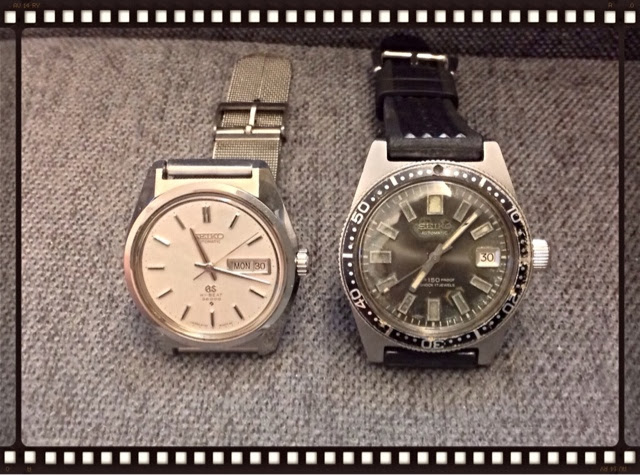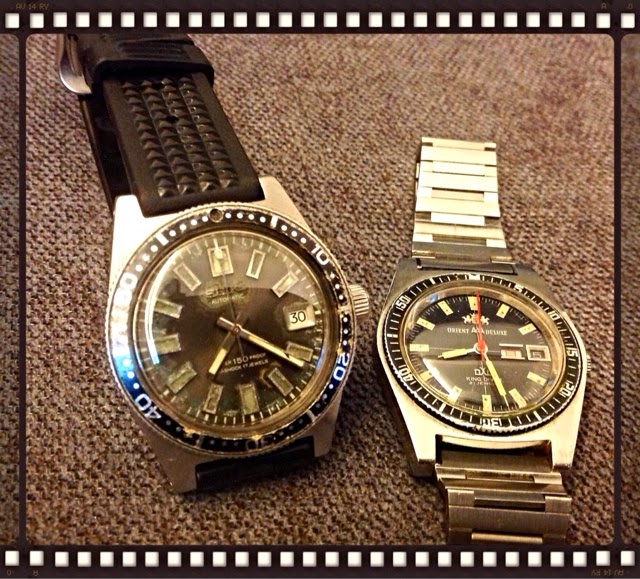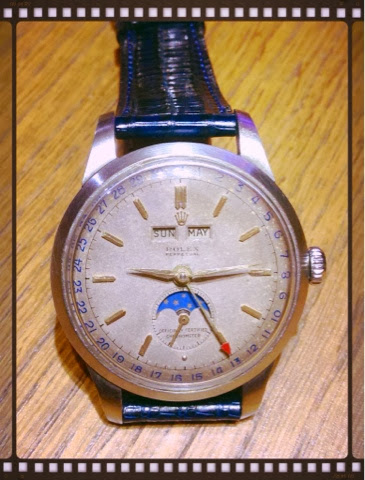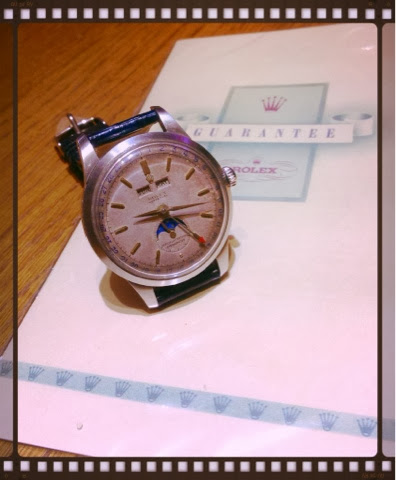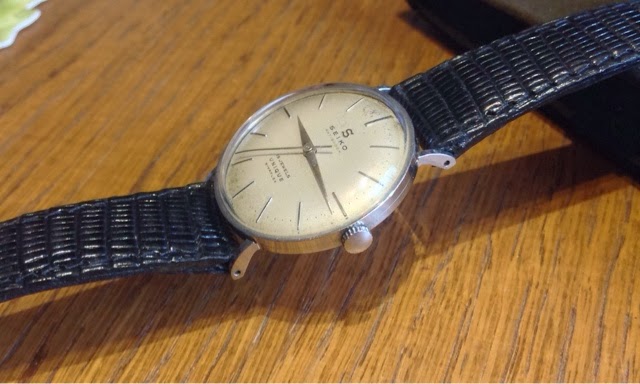Please Visit Rolex.2itb.com http://www.horsyland.com https://photographic-experience.blogspot.hk/
Tuesday, December 31, 2013
Monday, December 30, 2013
Vintage Japanese watches
Just started collecting the vintage Japanese watches and even though this is not the mainstream, the fun is there.
Saturday, December 28, 2013
Friday, December 27, 2013
Seiko 5646 7040 (http://www.discuss.com.hk/viewthread.php?tid=22248521)
跟據森年樹的"國產之時計 Seiko自動卷 增補版"所述 , 1970年開始生產的56系Grand Seiko是舊世代GS的最後一個機芯系列. 與較前期的61系相比, 56系機芯雖然也名為Hi Beat機芯, 但每秒則只有8次震動 (即每小時28800次), 比61系的每秒10次震動為少. 據說較低震頻較適合自動化生產, 所以56系GS的產量在70至73年的生產期間比此前其他系列的GS手錶為多, 現時在二手時場也較易找到.
56GS下有 5641A, 5645A (有日期顯示)和 5646A (有日期和星期顯示), 款式方面相當多, 但據網上資料, 各款產量並不平均; 當中最常見的是7010, 而這post的主角 7040 則甚為罕見. 據森氏所言, 5646 7040 是眾多舊世代GS錶款中唯一一款錶盤刻度全以阿拉伯數字表示, 故雖然56GS機芯不屬頂級 (以複雜程度以言), 但7040的錶款郤一向是收藏家的目標. (新世代的GS以阿拉伯數字入盤的款式則不下一款, 小弟現時最想購入的是 SBGW003).
背景資料帶過, 主角要出場了. 話說呢隻 7040 長期係我的 wish list 上, 但自知要搵佢同中六合彩一樣, 要靠運氣, 所以一直都只係等; browse yahoo auction jp 以及各大日本中古錶站. 直至早兩星期, 居然畀我見到佢 (仲要係可以先睇實貨), 價錢雖不算可人, 但至少唔係罕物的天價, 而且狀態良好, 所以我二話不說, 還左一口價就帶佢返屋企了.
1.

此錶錶面造成像未打磨/粗磨砂的白銀一樣, 所以正面影出黎好易令人誤會係"甩青", 但其實只係設計效果. 除3字外, 1至12點均以富藝術感的阿拉伯數字表示. 而3點位置則有日期和星期顯示(星期可以kanji或英語顯示)
錶底是舊世代GS後期的 "GS"底 (如果是獅子底就好了); 上面刻有 5646 7040的字樣:

錶的當然也是常見的款式

一個細節令我買的時侯有幾分猶豫, 就是面盤底下的數字. 從下圖可見, 六點位置底下所刻的數字是 "5646 -7050T". 點解錶款係 7040, 但面盤所寫既係7050T呢? 返到屋企之後, 我睇返森氏本書, 見佢張相(雖然圖太細, 上面D字唔係好清楚, 但4同5都叫做分得到)都係寫住 7050T, 咁應該可以放心啦. 但為满足求知欲, 都係繼續google左一陣, 結果係一個日本錶網上見到一個trading post, 有個日本人出一隻5646 7030 (又係極少見), 佢係錶既介紹上亦有提到佢隻錶錶底係寫5646 7030, 但錶面係 5646 7040T, 佢仲特登為此去搵過中古店老闆問過, 得到既回覆係 5645 / 5646 既幾個款都係咁 (底同面既數字唔一樣), 但出廠就係咁, 唔使擔心咁話. 佢咁講, 我就咁信啦.

介紹係咁多, 我本來諗住買返黎都係要攞去OH先, 但一週以來, 發現隻錶不論平放定戴半日(10個鐘左右係office),都係每日慢兩秒左右, 堅過石堅.
唯一美中不足, 就係我覺得佢D數字唔夠 lord marvel 個D靚 / 咁明顯囉 (不過呢隻個錶款擺明係要黎做bling bling 飾物, 無計)

56GS下有 5641A, 5645A (有日期顯示)和 5646A (有日期和星期顯示), 款式方面相當多, 但據網上資料, 各款產量並不平均; 當中最常見的是7010, 而這post的主角 7040 則甚為罕見. 據森氏所言, 5646 7040 是眾多舊世代GS錶款中唯一一款錶盤刻度全以阿拉伯數字表示, 故雖然56GS機芯不屬頂級 (以複雜程度以言), 但7040的錶款郤一向是收藏家的目標. (新世代的GS以阿拉伯數字入盤的款式則不下一款, 小弟現時最想購入的是 SBGW003).
背景資料帶過, 主角要出場了. 話說呢隻 7040 長期係我的 wish list 上, 但自知要搵佢同中六合彩一樣, 要靠運氣, 所以一直都只係等; browse yahoo auction jp 以及各大日本中古錶站. 直至早兩星期, 居然畀我見到佢 (仲要係可以先睇實貨), 價錢雖不算可人, 但至少唔係罕物的天價, 而且狀態良好, 所以我二話不說, 還左一口價就帶佢返屋企了.
1.

此錶錶面造成像未打磨/粗磨砂的白銀一樣, 所以正面影出黎好易令人誤會係"甩青", 但其實只係設計效果. 除3字外, 1至12點均以富藝術感的阿拉伯數字表示. 而3點位置則有日期和星期顯示(星期可以kanji或英語顯示)
錶底是舊世代GS後期的 "GS"底 (如果是獅子底就好了); 上面刻有 5646 7040的字樣:

錶的當然也是常見的款式

一個細節令我買的時侯有幾分猶豫, 就是面盤底下的數字. 從下圖可見, 六點位置底下所刻的數字是 "5646 -7050T". 點解錶款係 7040, 但面盤所寫既係7050T呢? 返到屋企之後, 我睇返森氏本書, 見佢張相(雖然圖太細, 上面D字唔係好清楚, 但4同5都叫做分得到)都係寫住 7050T, 咁應該可以放心啦. 但為满足求知欲, 都係繼續google左一陣, 結果係一個日本錶網上見到一個trading post, 有個日本人出一隻5646 7030 (又係極少見), 佢係錶既介紹上亦有提到佢隻錶錶底係寫5646 7030, 但錶面係 5646 7040T, 佢仲特登為此去搵過中古店老闆問過, 得到既回覆係 5645 / 5646 既幾個款都係咁 (底同面既數字唔一樣), 但出廠就係咁, 唔使擔心咁話. 佢咁講, 我就咁信啦.

介紹係咁多, 我本來諗住買返黎都係要攞去OH先, 但一週以來, 發現隻錶不論平放定戴半日(10個鐘左右係office),都係每日慢兩秒左右, 堅過石堅.
唯一美中不足, 就係我覺得佢D數字唔夠 lord marvel 個D靚 / 咁明顯囉 (不過呢隻個錶款擺明係要黎做bling bling 飾物, 無計)

Thursday, December 26, 2013
Wednesday, December 25, 2013
HOW TO BUY SEIKO´S FIRST DIVER - 6217-800x "62MAS" (information from the net)
HOW TO BUY SEIKO´S FIRST DIVER - 6217-800x "62MAS"

The following is a Seiko 6217 reference/buyers guide inspired by Isthmus´ HOW TO BUY A SEIKO 6309 DIVER. The content is based my own observations, together with information compiled from the SCWF archives [1]; information and images found on Kevin Chan´s Seiko Diver´s Reference [2], the Seiko Divers Gallery [3], Shawn´s First Diver Heaven [4] and Seiko´s book: "A Journey In Time: The Remarkable Story of Seiko" (2003) [5]; together with valuable feedback from Fermin Saranilla (Fermz), Seikomart and Clayton (Hawk 54). Please feel free to update, correct and append this buyer´s guide &*8211; thanks in advance for your contributions!
- Harry Teicher, 2008
______________________________________________
QUICK REFERENCE
Movement/case: 6217-8000; 6217-8001
Movement: 6217A (62MAS)
Production: 1965-1968
Case size: 37mm (42mm with the crown)
Lug width: 19mm (same as 6105-800x and 6105-811x)
Thickness: 13.5mm
Functions: 150M water proof, bi- directional rotating bezel, date
The 150m water proof 6217 "62MAS" is Seiko (and Japan´s) first true diver, and as such enjoys a position of undisputed horological significance. As Seiko´s first diver it has high collectability in its own right, and is the cornerstone of any significant collection of vintage Seiko divers, be it a collection of 150m divers, shrouded divers or Professional (Prospex) models. In short - the collectability of the 62MAS does not need any further justification &*8211; no other Seiko diver can claim to be the first!

Family photo: first generation 62MAS diver (left) third generation 6309 diver (center) and pre-diver Sportsmatic 30m Silverwave (right)
Reflecting the era of its production, the 62MAS is relatively small in comparison to the subsequent legendary line of Seiko divers. Although it is quite scarce, good examples do surface relatively often. Original dials and bezel inserts can be very difficult to find, and command a premium when they do turn up. In contrast to the boldness of subsequent Seiko divers, the first model diver truly reflects the discrete styling of 60´s watches, making it equally at home under a tuxedo, at a business meeting or strapped over a wetsuit in the depths of the ocean!
HERITAGE
During the 1950s and 1960s, sport scuba diving had become increasingly popular. Increasing prosperity coupled with scuba technology developed during WWII gave private divers access to revolutionary equipment &*8211; including true divers watches. The advent of modern bezelled dive watches dawned in 1953 with the introduction of the Rolex Submariner and Blancpain Fifty Fathoms. Paradoxically, until the second half of the 1960s, landlocked Switzerland was the principal producer of dive watches for civilian diving!
Prior to the 1964 Tokyo Olympics (with Seiko as Official Timer), Seiko had introduced its first range of truly submersible sport watches with (internal) rotating countdown bezels( in the form of the Seikomatic 50m Silverwave (1962)and the Sportsmatic 30m Silverwave (1964). These sports divers were the immediate precursors to Seiko (and Japans) first professional diver comprising 150m depth capability, shockproofing, extreme legibility and an external timing bezel,the 62MAS(1965).

1964 Seikomatic 30m Silverwave sports diver (left) with 1967 62MAS first professional diver (right)
Although the 62MAS is relatively discrete in comparison to the subsequent, legendary line of Seiko divers, the 62MAS was at the time considered to be a bold, rather large watch. Shown between the 1964 Seikomatic 30m Silverwave, the 62MAS can be seen to have a more substantial case, larger crown and bolder hands and markers, in accordance with the increased depth rating of the 62MAS.
In order to showcase of its ruggedness, the 62MAS was successfully worn for three months by the 8th Antarctic Wintering Team in 1966:


In 1967, Seiko engineers had developed the technology to build the first 300m divers watch (6215-010), heralding the introduction of Seiko´s high-end professional divers. 1968 saw the introduction of the second-model 150m divers, the 6105 series, which implemented a number of improvements to the 62MAS including a locking crown, more substantial case including integrated crown guard, improved screw-down caseback design and the replacement of the domed acrylic crystal with Seiko´s proprietary Hardlex crystal.
CASEBACK AND DATING
First model (62MAS) divers have one of two caseback types: dolphin-logo or SEIKO-logo (similar to the later 6105 second model divers). Both caseback types are marked &*8220;waterproof&*8221;, a designiation which was subsequently prohibited, with later divers using the more correct "water resistant". According to SCWF posts, Tokunaga-san claims the Dolphin case-back mark indicates self-winding water-proof watches. The earlier Seikomatic 50m (1962) and Sportsmatic 30m(1964)sports divers introduced the caseback wave logo, to denote their sports/waterproof nature, and subsequent lines of Seiko divers have sported various permutations of the wave logo, from simple, stylised waves for watches with lower water resistance to more detailed full Tsunami wave logo for the true divers.




Dolphin, back & front (left) and non-dolphin back and front caseback (right)
It can be difficult to find a caseback in good condition, as the detailing of the 1960s casebacks is easily polished off through extended use.
Case back numbers include the model identification ie: 6217-8001 or 6217-8000, as well as the 7-digit serial number. I assume that the different model numbers indicate different markets, similar to the 6309 model numbering. Seiko started the 6 digit serial numbering system in 1968, for dating purposes it is relevant to know that the 1st digit is the year, while the 2nd digit is the month: i.e. 72xxxxx indicates the watch was produced in February 1977.
CROWN
The rather massive crown (about the same size as the 6309) gives Seiko´s first model diver a particularly purposeful look, without detracting from the overall symmetry of the watch.

The 62MAS is the only of Seiko´s dive watches not to sport crown guards. The crown does not screw down or lock, and is signed with a Seiko logo. The 150m rating of the 62MAS and its successors is achieved through the judicious use of seals &*8211; the later use of screw down and lock mechanisms as well as crown guards do not impart water resistance per se, but rather protect the stem and seals from knocks and snags which might compromise the integrity of the seals.


Aftermarket crown(left), original crown (right)
Aftermarket replacement crowns for the 6105-8000/8009 and 6217 are readily available on eBay (Stephen Go, &*8220;thewatchworks&*8221;). Aftermarket crowns are almost identical to the originals, although the flat Seiko-marked face of the aftermarket crowns appears to be marginally larger than on the originals.
DIAL AND HANDS
The dial has a metallic, coppery sheen, similar to the dial of its Sportsmatic 30m sports/waterproof predecessor and the 6601-8830 Seahorse (see below). In contrast to the trademark batons of earlier Seiko sports dials, Seiko opted for deep, chrome-lined rectangular lume wells &*8211; thickness being a factor determining the intensity of the lume.

First model diver (62MAS, left) and second generation 6105-8000 and 6105-8009 divers
These rectangular lume wells were continued for the second model (6105) diver series and were replaced in the third model (6309) series divers by thickly applied lume &*8220;dots&*8221;. With the advent of newer luminescent technologies, lume thickness appears to have become less of an issue and lume wells have been eliminated or replaced by decorative chrome or white-gold lume borders in high-end watches (interestingly, early 50s and 60s "tool watch" Rolex submariner dials did not use lume borders or wells, making do with simple lume dots similar to those of Seiko´s third model (6309) series divers).
The lume on the NOS original dials and hands I have seen have had a faint green tinge, although I have seen NOS-advertised watches with snow-white lume. I suspect that the lume may lose its green tinge with age, or these dials and hands may have been relumed.



Aftermarket (left) and original (center, right) dials
Original dials are virtually impossible to source, although aftermarket dials are available. Generally, the lume wells of the aftermarket replacements are more symmetrical and evenly made than the original wells, which appear to be rather primitively cast.
The minute and hour hands are simple, bevelled and lumed baton hands, and are the same as those used on the second model (6105) divers as well as a number of other models, including the 7005-8052 70m diver, the 7025 70m Diver and the 6601-8830Seahorse (which also has a dial remarkably similar to the 6217 diver!)


6601-8830 Seahorse dial and hands (left) and 7005-8052 70m diver dial and hands (right)
Other Seiko models have similar hands that are narrower, or have lume on the minute hand which doesn´t extend to the tip of the hand. The correct hands are bevelled on each edge of the lume, rather than bevelled down the middle of the hands.

Original dial showing correct bevelled hands
The seconds hand with the box lume tip is not the same as that used on the 6105 series divers, but is identical to those of the 7005-8052 and 6601-8830.
BEZEL
The first model diver´s bezel is bi-directional with no "clicks". The bezel insert is narrower than subsequent Seiko diver´s bezels, and the bezel itself is very finely &*8220;knurled&*8221;. The bezel is a fine example of discrete 60s styling, and its very high quality reminds me of camera lenses and scientific equipment of the same era. Accordingly, the 62MAS lives up to the Seiko name: Seiko is a Japanese word meaning "exquisite".



Original, NOS bezels and inserts
In contrast to bezel inserts on subsequent models, the lume dot is not surrounded by a silver triangle, and there are 4 minute dots on either side of the lume &*8220;pip&*8221;. &*8220;Aftermarket&*8221; bezel inserts are typically 6105 or 6309 aftermarket bezels turned on a lathe to fit &*8211; subsequently, the tops and bottoms of the numbers have been removed and these bezel inserts are easy to identify.


"Incorrect" (left) and original (right) bezel inserts
At the time of writing this guide (2008), &*8220;correct&*8221; aftermarket inserts are not available. NOS bezels and inserts do occasionally surface, although the last6217-8001 bezel I saw on eBay went for several hundred dollars!
STRAP
This subject has been the subject of a number of forum discussions, and it appears that the 62MAS was originally provided with the "tire tread" strap (based on the 1967 Seiko catalogue pictured below) but the waffle strap has been reported on a number of NOS pieces (seen also in Seiko´s book: "A Journey In Time: The Remarkable Story of Seiko" (2003) [5]) and was probably also available during this period.


Waffle type rubber straps
Many 62MAS are seen today on a period "Tropic" strap, and the general consensus is that the &*8220;tire-tread&*8221;, &*8220;waffle&*8221; and (to a degree) the &*8220;tropic&*8221; rubber straps are acceptably original.


Tire Tread strap from original 1967 brochure (left) and period-correct "Tropic" (right)rubber straps
Lug width of the 62MAS is 19mm, and the watch uses original C190FS (OEM SEIKO) fat spring bars. These bars are 2.5mm thick and have 1.00mm ends.

CRYSTAL
The first model (62MAS) divers were fitted with a 31.5mm acrylic crystal, held in place by a metal tension ring. Seiko-branded replacement acrylic crystals marked * 315T01ANS are quite readily available on eBay, and similar Chronostop crystals may also be used (Jose Sotto on eBay).


Replacement crystal (left) and domed original crystal (right)
The crystal is thick and relatively domed, sitting high above the bezel &*8211; making the crystal prone to scratching. Fortunately, most scratches on acrylic crystals can easily be buffed out!
MOVEMENT
The first model (62MAS) divers are powered by the 17J 6217A (movement: 62; prefix: 17A; model: 62MAS) date-only automatic movement, beating at a sedate 18000bph (5bps). The movement has a diameter of 28mm and a thickness of 5.3mm. This movement lacks hacking and handwinding capabilities, although the date is quickset. It is the consensus on the SCWF forum that MAS stands for &*8220;autoMAtic (MACHIKKU) Selfdater&*8221;.


17J 6217A automatic movement
The 6217A movement was produced from 1964 until 1968 at Seiko´s Suwa Plant in Suwa, Nagano Prefecture, and was originally used in the 1964 World Time. In order to facilitate the 24hr function, an additional wheel and hand are added to the 6217A movement (subsequently termed MASWT).

Replacement (or upgrade) 24J 6205B automatic movement
The 6217A is a cousin of (and can be replaced/upgraded with) the 24J 6205B movement used in the Seiko Selfdater 6205-8960 of the same period. These movements can be found for under 50USD on eBay.
62MAS IN MODERN CULTURE
In agreement with its discrete appearance, first model (62MAS) divers have kept a relatively low profile in the media. Apart from their publicised participation in the 8th Antarctic wintering Team (1966) Romer Treece (Robert Shaw) wears a Seiko 6217 diver in the movie The Deep (1977).
PRICES
In 1965, Seiko´s first model diver (62MAS) sold for 13,000JPY, approximately half the monthly wage of a Japanese college graduate. By way of comparison, the precursor sport/waterproof 50m Silver Wave 6201B (1960) cost 11,000JPY while its lower-spec successor, the 6601-7990 30m Sportsmatic Silverwave sports diver cost about 8,200JPY in 1964. The Silverwaves today cost about 150 USD, while 62MAS divers typically (2008) sell in excess of 500USD (NOS examples reaching 1500USD or more!). Although the Silverwaves are relatively scarce and historically significantly as precursors to Seiko´s first diver, the 62MAS price development clearly reflects the horological significance of this piece in any Seiko diver collection.
______________________________________________
REFERENCES
[1] Seiko and Citizen watch forum. http://www.network54.com/Forum/78440/>
[2] Kevin Chan´s Seiko Diver´s Reference.http://www.makedostudio.com/watches/seiko-divers/index.html>
[3] Seiko Divers Gallery. http://www.makedostudio.com/watches/seiko-divers/gallery/6217>
[4] Shawn´s First Model Diver Heaven.http://www.network54.com/Forum/78440/message/1059022593/FIRST+MODEL+DIVER+HEAVEN>
[5] "A Journey In Time: The Remarkable Story of Seiko" (2003)
[6] The stuff WIS legends are made of...http://www.biosciencecommunications.dk/Seiko/6217.html>
Source:

The following is a Seiko 6217 reference/buyers guide inspired by Isthmus´ HOW TO BUY A SEIKO 6309 DIVER. The content is based my own observations, together with information compiled from the SCWF archives [1]; information and images found on Kevin Chan´s Seiko Diver´s Reference [2], the Seiko Divers Gallery [3], Shawn´s First Diver Heaven [4] and Seiko´s book: "A Journey In Time: The Remarkable Story of Seiko" (2003) [5]; together with valuable feedback from Fermin Saranilla (Fermz), Seikomart and Clayton (Hawk 54). Please feel free to update, correct and append this buyer´s guide &*8211; thanks in advance for your contributions!
- Harry Teicher, 2008
______________________________________________
QUICK REFERENCE
Movement/case: 6217-8000; 6217-8001
Movement: 6217A (62MAS)
Production: 1965-1968
Case size: 37mm (42mm with the crown)
Lug width: 19mm (same as 6105-800x and 6105-811x)
Thickness: 13.5mm
Functions: 150M water proof, bi- directional rotating bezel, date
The 150m water proof 6217 "62MAS" is Seiko (and Japan´s) first true diver, and as such enjoys a position of undisputed horological significance. As Seiko´s first diver it has high collectability in its own right, and is the cornerstone of any significant collection of vintage Seiko divers, be it a collection of 150m divers, shrouded divers or Professional (Prospex) models. In short - the collectability of the 62MAS does not need any further justification &*8211; no other Seiko diver can claim to be the first!

Family photo: first generation 62MAS diver (left) third generation 6309 diver (center) and pre-diver Sportsmatic 30m Silverwave (right)
Reflecting the era of its production, the 62MAS is relatively small in comparison to the subsequent legendary line of Seiko divers. Although it is quite scarce, good examples do surface relatively often. Original dials and bezel inserts can be very difficult to find, and command a premium when they do turn up. In contrast to the boldness of subsequent Seiko divers, the first model diver truly reflects the discrete styling of 60´s watches, making it equally at home under a tuxedo, at a business meeting or strapped over a wetsuit in the depths of the ocean!
HERITAGE
During the 1950s and 1960s, sport scuba diving had become increasingly popular. Increasing prosperity coupled with scuba technology developed during WWII gave private divers access to revolutionary equipment &*8211; including true divers watches. The advent of modern bezelled dive watches dawned in 1953 with the introduction of the Rolex Submariner and Blancpain Fifty Fathoms. Paradoxically, until the second half of the 1960s, landlocked Switzerland was the principal producer of dive watches for civilian diving!
Prior to the 1964 Tokyo Olympics (with Seiko as Official Timer), Seiko had introduced its first range of truly submersible sport watches with (internal) rotating countdown bezels( in the form of the Seikomatic 50m Silverwave (1962)and the Sportsmatic 30m Silverwave (1964). These sports divers were the immediate precursors to Seiko (and Japans) first professional diver comprising 150m depth capability, shockproofing, extreme legibility and an external timing bezel,the 62MAS(1965).

1964 Seikomatic 30m Silverwave sports diver (left) with 1967 62MAS first professional diver (right)
Although the 62MAS is relatively discrete in comparison to the subsequent, legendary line of Seiko divers, the 62MAS was at the time considered to be a bold, rather large watch. Shown between the 1964 Seikomatic 30m Silverwave, the 62MAS can be seen to have a more substantial case, larger crown and bolder hands and markers, in accordance with the increased depth rating of the 62MAS.
In order to showcase of its ruggedness, the 62MAS was successfully worn for three months by the 8th Antarctic Wintering Team in 1966:


In 1967, Seiko engineers had developed the technology to build the first 300m divers watch (6215-010), heralding the introduction of Seiko´s high-end professional divers. 1968 saw the introduction of the second-model 150m divers, the 6105 series, which implemented a number of improvements to the 62MAS including a locking crown, more substantial case including integrated crown guard, improved screw-down caseback design and the replacement of the domed acrylic crystal with Seiko´s proprietary Hardlex crystal.
CASEBACK AND DATING
First model (62MAS) divers have one of two caseback types: dolphin-logo or SEIKO-logo (similar to the later 6105 second model divers). Both caseback types are marked &*8220;waterproof&*8221;, a designiation which was subsequently prohibited, with later divers using the more correct "water resistant". According to SCWF posts, Tokunaga-san claims the Dolphin case-back mark indicates self-winding water-proof watches. The earlier Seikomatic 50m (1962) and Sportsmatic 30m(1964)sports divers introduced the caseback wave logo, to denote their sports/waterproof nature, and subsequent lines of Seiko divers have sported various permutations of the wave logo, from simple, stylised waves for watches with lower water resistance to more detailed full Tsunami wave logo for the true divers.




Dolphin, back & front (left) and non-dolphin back and front caseback (right)
It can be difficult to find a caseback in good condition, as the detailing of the 1960s casebacks is easily polished off through extended use.
Case back numbers include the model identification ie: 6217-8001 or 6217-8000, as well as the 7-digit serial number. I assume that the different model numbers indicate different markets, similar to the 6309 model numbering. Seiko started the 6 digit serial numbering system in 1968, for dating purposes it is relevant to know that the 1st digit is the year, while the 2nd digit is the month: i.e. 72xxxxx indicates the watch was produced in February 1977.
CROWN
The rather massive crown (about the same size as the 6309) gives Seiko´s first model diver a particularly purposeful look, without detracting from the overall symmetry of the watch.

The 62MAS is the only of Seiko´s dive watches not to sport crown guards. The crown does not screw down or lock, and is signed with a Seiko logo. The 150m rating of the 62MAS and its successors is achieved through the judicious use of seals &*8211; the later use of screw down and lock mechanisms as well as crown guards do not impart water resistance per se, but rather protect the stem and seals from knocks and snags which might compromise the integrity of the seals.


Aftermarket crown(left), original crown (right)
Aftermarket replacement crowns for the 6105-8000/8009 and 6217 are readily available on eBay (Stephen Go, &*8220;thewatchworks&*8221;). Aftermarket crowns are almost identical to the originals, although the flat Seiko-marked face of the aftermarket crowns appears to be marginally larger than on the originals.
DIAL AND HANDS
The dial has a metallic, coppery sheen, similar to the dial of its Sportsmatic 30m sports/waterproof predecessor and the 6601-8830 Seahorse (see below). In contrast to the trademark batons of earlier Seiko sports dials, Seiko opted for deep, chrome-lined rectangular lume wells &*8211; thickness being a factor determining the intensity of the lume.

First model diver (62MAS, left) and second generation 6105-8000 and 6105-8009 divers
These rectangular lume wells were continued for the second model (6105) diver series and were replaced in the third model (6309) series divers by thickly applied lume &*8220;dots&*8221;. With the advent of newer luminescent technologies, lume thickness appears to have become less of an issue and lume wells have been eliminated or replaced by decorative chrome or white-gold lume borders in high-end watches (interestingly, early 50s and 60s "tool watch" Rolex submariner dials did not use lume borders or wells, making do with simple lume dots similar to those of Seiko´s third model (6309) series divers).
The lume on the NOS original dials and hands I have seen have had a faint green tinge, although I have seen NOS-advertised watches with snow-white lume. I suspect that the lume may lose its green tinge with age, or these dials and hands may have been relumed.



Aftermarket (left) and original (center, right) dials
Original dials are virtually impossible to source, although aftermarket dials are available. Generally, the lume wells of the aftermarket replacements are more symmetrical and evenly made than the original wells, which appear to be rather primitively cast.
The minute and hour hands are simple, bevelled and lumed baton hands, and are the same as those used on the second model (6105) divers as well as a number of other models, including the 7005-8052 70m diver, the 7025 70m Diver and the 6601-8830Seahorse (which also has a dial remarkably similar to the 6217 diver!)


6601-8830 Seahorse dial and hands (left) and 7005-8052 70m diver dial and hands (right)
Other Seiko models have similar hands that are narrower, or have lume on the minute hand which doesn´t extend to the tip of the hand. The correct hands are bevelled on each edge of the lume, rather than bevelled down the middle of the hands.

Original dial showing correct bevelled hands
The seconds hand with the box lume tip is not the same as that used on the 6105 series divers, but is identical to those of the 7005-8052 and 6601-8830.
BEZEL
The first model diver´s bezel is bi-directional with no "clicks". The bezel insert is narrower than subsequent Seiko diver´s bezels, and the bezel itself is very finely &*8220;knurled&*8221;. The bezel is a fine example of discrete 60s styling, and its very high quality reminds me of camera lenses and scientific equipment of the same era. Accordingly, the 62MAS lives up to the Seiko name: Seiko is a Japanese word meaning "exquisite".



Original, NOS bezels and inserts
In contrast to bezel inserts on subsequent models, the lume dot is not surrounded by a silver triangle, and there are 4 minute dots on either side of the lume &*8220;pip&*8221;. &*8220;Aftermarket&*8221; bezel inserts are typically 6105 or 6309 aftermarket bezels turned on a lathe to fit &*8211; subsequently, the tops and bottoms of the numbers have been removed and these bezel inserts are easy to identify.


"Incorrect" (left) and original (right) bezel inserts
At the time of writing this guide (2008), &*8220;correct&*8221; aftermarket inserts are not available. NOS bezels and inserts do occasionally surface, although the last6217-8001 bezel I saw on eBay went for several hundred dollars!
STRAP
This subject has been the subject of a number of forum discussions, and it appears that the 62MAS was originally provided with the "tire tread" strap (based on the 1967 Seiko catalogue pictured below) but the waffle strap has been reported on a number of NOS pieces (seen also in Seiko´s book: "A Journey In Time: The Remarkable Story of Seiko" (2003) [5]) and was probably also available during this period.


Waffle type rubber straps
Many 62MAS are seen today on a period "Tropic" strap, and the general consensus is that the &*8220;tire-tread&*8221;, &*8220;waffle&*8221; and (to a degree) the &*8220;tropic&*8221; rubber straps are acceptably original.


Tire Tread strap from original 1967 brochure (left) and period-correct "Tropic" (right)rubber straps
Lug width of the 62MAS is 19mm, and the watch uses original C190FS (OEM SEIKO) fat spring bars. These bars are 2.5mm thick and have 1.00mm ends.

CRYSTAL
The first model (62MAS) divers were fitted with a 31.5mm acrylic crystal, held in place by a metal tension ring. Seiko-branded replacement acrylic crystals marked * 315T01ANS are quite readily available on eBay, and similar Chronostop crystals may also be used (Jose Sotto on eBay).


Replacement crystal (left) and domed original crystal (right)
The crystal is thick and relatively domed, sitting high above the bezel &*8211; making the crystal prone to scratching. Fortunately, most scratches on acrylic crystals can easily be buffed out!
MOVEMENT
The first model (62MAS) divers are powered by the 17J 6217A (movement: 62; prefix: 17A; model: 62MAS) date-only automatic movement, beating at a sedate 18000bph (5bps). The movement has a diameter of 28mm and a thickness of 5.3mm. This movement lacks hacking and handwinding capabilities, although the date is quickset. It is the consensus on the SCWF forum that MAS stands for &*8220;autoMAtic (MACHIKKU) Selfdater&*8221;.


17J 6217A automatic movement
The 6217A movement was produced from 1964 until 1968 at Seiko´s Suwa Plant in Suwa, Nagano Prefecture, and was originally used in the 1964 World Time. In order to facilitate the 24hr function, an additional wheel and hand are added to the 6217A movement (subsequently termed MASWT).

Replacement (or upgrade) 24J 6205B automatic movement
The 6217A is a cousin of (and can be replaced/upgraded with) the 24J 6205B movement used in the Seiko Selfdater 6205-8960 of the same period. These movements can be found for under 50USD on eBay.
62MAS IN MODERN CULTURE
In agreement with its discrete appearance, first model (62MAS) divers have kept a relatively low profile in the media. Apart from their publicised participation in the 8th Antarctic wintering Team (1966) Romer Treece (Robert Shaw) wears a Seiko 6217 diver in the movie The Deep (1977).
PRICES
In 1965, Seiko´s first model diver (62MAS) sold for 13,000JPY, approximately half the monthly wage of a Japanese college graduate. By way of comparison, the precursor sport/waterproof 50m Silver Wave 6201B (1960) cost 11,000JPY while its lower-spec successor, the 6601-7990 30m Sportsmatic Silverwave sports diver cost about 8,200JPY in 1964. The Silverwaves today cost about 150 USD, while 62MAS divers typically (2008) sell in excess of 500USD (NOS examples reaching 1500USD or more!). Although the Silverwaves are relatively scarce and historically significantly as precursors to Seiko´s first diver, the 62MAS price development clearly reflects the horological significance of this piece in any Seiko diver collection.
______________________________________________
REFERENCES
[1] Seiko and Citizen watch forum. http://www.network54.com/Forum/78440/>
[2] Kevin Chan´s Seiko Diver´s Reference.http://www.makedostudio.com/watches/seiko-divers/index.html>
[3] Seiko Divers Gallery. http://www.makedostudio.com/watches/seiko-divers/gallery/6217>
[4] Shawn´s First Model Diver Heaven.http://www.network54.com/Forum/78440/message/1059022593/FIRST+MODEL+DIVER+HEAVEN>
[5] "A Journey In Time: The Remarkable Story of Seiko" (2003)
[6] The stuff WIS legends are made of...http://www.biosciencecommunications.dk/Seiko/6217.html>
Source:
http://forums.watchuseek.com/f281/how-buy-seiko-6217-800x-62mas-diver-collectors-buying-guide-155123.html
Subscribe to:
Posts (Atom)
Problem with signing in
I am facing issues with saving my blog with photos and I cannot seemed to log on using my ipad. Perhaps, the days have pme to end the blog....
-
2019 is going to be a good year as I have managed to find a nice 42mm Droz super compressor from Stockholm Sweden. Droz R.A.N. (Royal Austra...
-
The Seiko 7002 series of diving watches is the fourth generation of Seikos professional/recreational ISO-rated automatic diving watches. As ...



